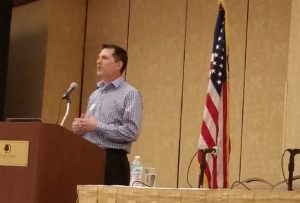
NABR: Setting right labor rates keeps customers safe, allows body shop to meet future costs
By onAssociations | Business Practices | Education | Market Trends | Repair Operations
Establishing appropriate labor rates protects consumers as well as your business, National AutoBody Research President Sam Valenzuela argued Tuesday.
Without labor rates sufficient to cover the tools, equipment and training needed for modern vehicles, a shop risks harming their customers with an improper repair, Valenzuela said.
Vehicles are just growing more technologically complex, and “we don’t really see an end to it,” said Valenzuela, who along with NABR CEO Richard Valenzuela will teach “4 Steps to Set Proper and Profitable Labor Rates for Your Individual Shop” 3-5 p.m. Tuesday, Oct. 30, during SCRS’ Repairer Driven Education series at SEMA.
Sam Valenzuela said NABR, which conducts the Variable Rate System surveys, has concluded that historical labor rates and even current prices “are really not adequate to support this new world.”
Valenzuela said the company is trying to help shops be more “business-minded” in determining their rates. In the past, labor rates for some shops seemed to be a function of whatever the insurer would pay “plus two or three dollars,” rather than grounded in some kind of financial rationale, Valenzuela said.
It might have worked in the past, but it wasn’t a good strategy now, according to Valenzuela.
Valenzuela said the course will focus on four factors necessary in setting intelligent labor rates. Two were probably applicable to many industries’ businesses, he said: the cost of living and inflation. He called the other two were more collision repair-specific: differentiation and current and future investments.
Differentiation referred to how a shop distinguished itself in the marketplace, according to Valenzuela. For example, the specific training and program costs related to becoming certified by a luxury OEM, he said. Other capital investments and training might fall into the general investment bucket, he said.
Asked if he saw shops breaking even or losing money because of insufficient labor rates, Valenzuela said, “We see stuff all over the board.”
He mentioned seeing some shops breaking even or losing money on paint materials.
On the whole, Valenzuela said the overall trend NABR saw was a slight “erosion” over time in gross profit, whether this is measured in dollars or a percentage of labor rate.
The company felt that had to be reversed, for labor was the main source of shop profits, according to Valenzuela.
While some income might be generated from paint and materials and parts, “that’s not their business,” he said.
Gross profit refers to revenue minus the cost of that revenue, according to Valenzuela. In this case, it’d be factors like the pay and benefits of the specific tech producing that specific labor hour. All other shop expenses needed to be paid out of the gross profit; for example, your estimator’s salary, or your sewer bill.
Adding in a shop’s expenses and considerations like training will eventually start putting pressure on a business.
“You can pretty quickly break the business case,” Valenzuela said.
Shops on average seem to be roughly collecting around $48-$50 per hour (which is different from the higher posted average NABR described in March), according Valenzuela. He said that amount “we just don’t see as sustainable” to keep up with the demands upon shops.
Volume helps compensate for a weak labor rate, but if crashes decline in the future as anticipated, this becomes a “tough equation,” Valenzuela said. (And if you’re losing money on every car you fix, volume is the last thing you want, as the old joke suggests.)
The collision repair business was a “pretty simple equation,” according to Valenzuela: “rate times volume.”
Valenzuela repeatedly stressed that every shop is going to be different, but a “really rough” suggestion would be a minimum 10 percent net profit margin and minimum of 50 percent gross profit. Twenty percent net and 60-70 percent gross would be better, he said.
He said NABR probably sees way too many instances when a shop has “low single-digit percentages” of net profit.
You’re still making money. But Valenzuela called an amount that low a “capital resource question.” The shop has less money left at the end of the year to work with. According to research by New York University professor Aswath Damodaran, the average profit margin across numerous industries was between 7-8 percent in January 2018.
Let’s say you had 2 percent net profit at the end of the year, but you need to give raises, pay a higher rent and cover increased paint costs, according to Valenzuela. There’s “less cushion” to do what you need to do in the future. Insufficient net profit means no one can get raises and the business stays as it is at that point in time, Valenzuela said.
Couldn’t you just raise your labor rate to cover those additional costs, leaving the net margin low but in existence?
“At least you’re not taking the thing to zero,” Valenzuela agreed. But he said he didn’t think anyone should rest on their laurels, and entrepreneurs needed to be in pursuit of increased profit.
There’s also little cushion during an economic or business downturn — for example, the recession last decade — if your net profit is too low. A business without enough money in the bank to cover a slow period might have difficulty making payroll, particularly if it can’t get credit.
Valenzuela said NABR likes to see higher margins and more money left over in body shops so the repairers have “more flexibility” and aren’t “so handcuffed.”
Volume from crashes is likely to decrease in a future of advanced driver assistance systems, to say nothing of autonomous vehicles. We asked Valenzuela if this might be offset by increased repair complexity adding more hours to each ticket.
He said some of it might simply be operations a shop had been doing for free in the past but now was beginning to include on invoices, such as covering a car.
It looks like greater profitability, but the shop might actually be catching up to where it should have been.
Valenzuela said some operations might switch from repairable to replace-only, which could reduce labor hours. Other new operations like calibration add more time but come with increased costs (for example, targets), he noted.
Attend Valenzuela’s session and other speakers’ courses by registering for the Repairer Driven Education series and OEM Collision Repair Technology Summit at SEMA.
Classes and individual OEM Collision Repair Summit sessions are $85. The best deal is the full-series pass for $400. It grants the repairer access to every RDE class, all three sessions of the Thursday, Nov. 1, OEM Collision Repair Technology Summit, the $100-ticket Sky Villa afterparty in Elvis’ old Westgate penthouse that night, and the brand new IDEAS Collide TED-style event Friday, Nov. 2.
More information:
SCRS Repairer Driven Education lineup
“4 Steps to Set Proper and Profitable Labor Rates for Your Individual Shop” course listing
Images:
National AutoBody Research President Sam Valenzuela speaks April 20, 2016, to the Collision Industry Conference. (John Huetter/Repairer Driven News)
Setting a labor rate too low can leave a shop operating at a loss or without enough net profit to cover future expense increases or weather a downturn in the shop’s business or the economy. (erhui1979/iStock)

